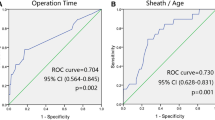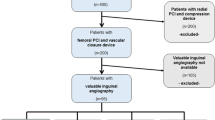Abstract
To evaluate whether avoidance of a risk factor associated with loss of pulse (LOP) following femoral artery (FA) catheterization in infants identified from previous study, was associated with decreased incidence of LOP during a prospective evaluation. Since initiation of routine ultrasound guided femoral arterial access (UGFAA) for infants undergoing catheterization in Jan 2003–Dec 2011 (Period-1), our incidence of LOP had stayed steady. Prospective evaluation between Jan 2012–Dec 2014 (Period-2), identified FA-diameter < 3 mm as risk factor for LOP. Between Jan 2015–Dec 2018 (Period-3), an initiative to avoid UGFAA for FA-diameter < 3 mm was implemented to determine whether that led to a decreased incidence of LOP. FA-diameter was measured prior to USGFAA and ratio of outer diameter of arterial sheath to luminal diameter of cannulated artery (OD/AD ratio) was calculated during Periods-2 and 3. The incidence and risk factors for LOP were assessed during the three periods. FA-access rates dropped significantly during Period-3 (56.7% vs. 93.8% and 90.4% during Periods-1 and 2, respectively, p < 0.001). Incidence of LOP in Period-3 decreased to 2.7% compared to 12.5% (Period-1) and 17.4% (Period-2) (p < 0.001). By multivariate analysis, FA size < 3 mm and an OD/AD ratio > 40% were the only significant independent predictors for LOP (OR 6.48, 95% CI 2.3–11.42, p < 0.001 and OR 4.16, 95% CI 1.79–8.65, p < 0.01, respectively). Access of femoral artery < 3 mm and OD/AD ratio > 50% are associated with increased incidence of LOP. Avoidance of these factors may help decrease complications in infants undergoing cardiac catheterizations.




Similar content being viewed by others
References
Glatz AC, Shah SS (2013) Prevalence of and risk factors for acute occlusive arterial injury following pediatric cardiac catheterization: a large single-center cohort study. Catheter Cardiovasc Int 82:454–462
Bergersen L, Gauvreau K, Jenkins KJ, Lock JE (2008) Adverse event rates in congenital cardiac catheterization: a new understanding of risks. Congenit Heart Dis 3:90–105
Bergersen L, Marshall A, Gauvreau K et al (2010) Adverse event rates in congenital cardiac catheterization—a multi-center experience. Catheter Cardiovasc Interv 75:389–400
Ino T, Benson LN, Freedom RM, Barker GA, Aipursky A, Rowe RD (1988) Thrombolytic therapy for femoral-artery thrombosis after pediatric cardiac-catheterization. Am Heart J 115:633–639
Kulkarni S, Naidu R (2006) Vascular ultrasound imaging to study immediate post catheterization vascular complications in children. Catheter Cardiovasc Interv 68:450–455
Lin PH, Dodson TF, Bush RL et al (2001) Surgical intervention for complications caused by femoral artery catheterization in pediatric patients. J Vasc Surg 34:1071–1078
Mehta R, Lee KJ, Chaturvedi R, Benson L (2008) Complications of pediatric cardiac catheterization: a review in the current era. Catheter Cardiovasc Interv 72:278–285
Phillips BL, Cabalka AK, Hagler DJ, Bailey KR, Cetta F (2010) Procedural complications during congenital cardiac catheterization. Cong Heart Dis 5:118–123
Saxena A, Gupta R, Kumar RK, Kothari SS, Wasir HS (1997) Predictors of arterial thrombosis after diagnostic cardiac catheterization in infants and children randomized to two heparin dosages. Catheter Cardiovasc Diagn 41:400–403
Stanger P, Heymann MA, Tarnoff H, Hoffman JIE, Rudolph AM (1974) Complications of cardiac-catheterization of neonates, infants, and children—3-year study. Circulation 50:595–608
Vitiello R, McCrindle BW, Nykanen D, Freedom RM, Benson LN (1998) Complications associated with pediatric cardiac catheterization. J Am Coll Cardiol 32:1433–1440
Wessel DL, Keane JF, Fellows KE, Robichaud H, Lock JE (1986) Fibrinolytic therapy for femoral arterial thrombosis after cardiac catheterization in infants and children. Am J Cardiol 58:347–351
Bulbul ZR, Galal MO, Mahmoud E et al (2002) Arterial complications following cardiac catheterization in children less than 10 kg. Asian Cardiovasc Thorac Ann 10:129–132
Altin RS, Flicker S, Naidech HJ (1989) Pseudoaneurysm and arteriovenous fistula after femoral artery catheterization: association with low femoral punctures. Am J Roentgenol 152:629–631
DuMond AA, Cruz E, Almodovar MC, Friesen RH (2012) Femoral artery catheterization in Neonates and infants. Pediatr Crit Care Med 13(1):39–41
Mortensson W, Hallbook T, Lundstrom NR (1975) Percutaneous catheterization of the femoral vessels in children. II. Thrombotic occlusion of the catheterized artery; frequency and causes. Pediatr Radiol 4:1–9
Alexander J et al (2016) Ultrasound-guided femoral arterial access in pediatric cardiac catheterizations: a prospective evaluation of the prevalence, risk factors and mechanism of acute loss of arterial pulse. Catheter Cardiovasc Interv 88(7):1098–1107
Mortensson W (1976) Angiography of the femoral artery following percutaneous catheterization in infants and children. Acta Radiol Diagn (Stockh) 17:581–593
Formanek G, Frech RS, Amplatz K (1970) Arterial thrombus formation during clinical percutaneous catheterization. Circulation 41:833–839
Glatz AC, Keashen R, Chang J, Balsama L, Dori Y, Gillespie MJ, Giglia T, Raffini L, Rome JJ (2014) Outcomes using a clinical practice pathway for the management of pulse loss following pediatric cardiac catheterization. Wiley, Hoboken
Kocis KC, Snider AR, Vermilion RP, Beekman RH (1995) 2-Dimensional and doppler ultrasound evaluation of femoral arteries in infants after cardiac-catheterization. Am J Cardiol 75:642–645
Munk A, Darge K, Wiesel M, Troeger J (2002) Diameter of the infrarenal and the iliac arteries in children: ultrasound measurements. Transplantation 73(4):631–635
Funding
This study did not receive any funding support.
Author information
Authors and Affiliations
Corresponding author
Ethics declarations
Conflict of interest
All authors declare that they have no conflict of interest.
Research Involving Human and Animal Rights
All procedures performed in studies involving human participants were in accordance with the ethical standards of the institutional and/or national research committee and with the 1964 Helsinki declaration and its later amendments or comparable ethical standards.
Informed Consent
Informed consent was waived by the institutional review board as the study included only data collection from an institutional standardized quality improvement initiative.
Additional information
Publisher's Note
Springer Nature remains neutral with regard to jurisdictional claims in published maps and institutional affiliations.
Rights and permissions
About this article
Cite this article
Tadphale, S., Yohannan, T., Kauffmann, T. et al. Accessing Femoral Arteries Less than 3 mm in Diameter is Associated with Increased Incidence of Loss of Pulse Following Cardiac Catheterization in Infants. Pediatr Cardiol 41, 1058–1066 (2020). https://doi.org/10.1007/s00246-020-02357-4
Received:
Accepted:
Published:
Issue Date:
DOI: https://doi.org/10.1007/s00246-020-02357-4




